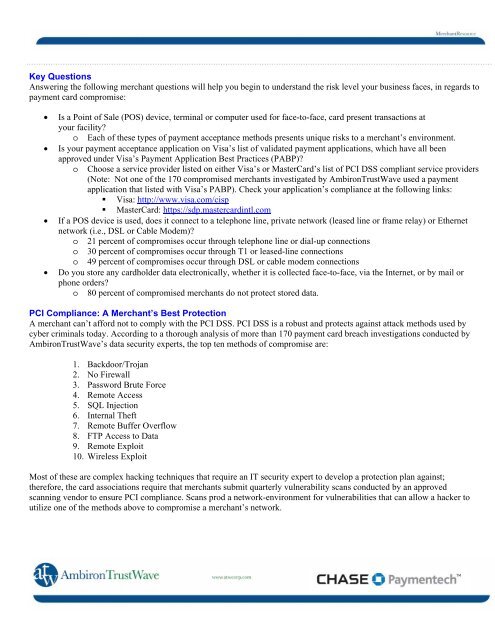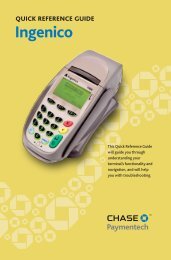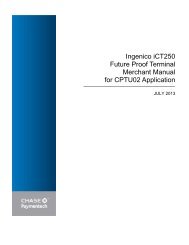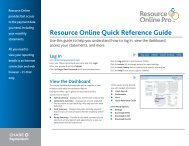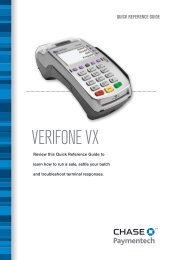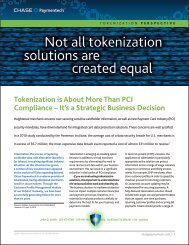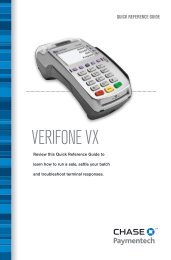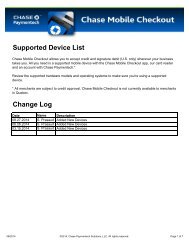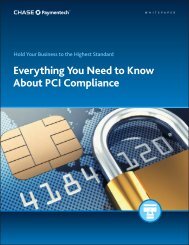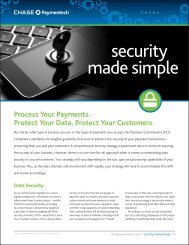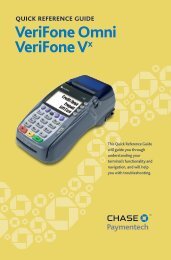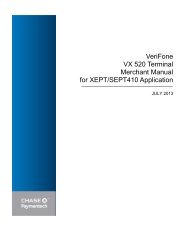Am I At Risk? - Chase Paymentech
Am I At Risk? - Chase Paymentech
Am I At Risk? - Chase Paymentech
- No tags were found...
Create successful ePaper yourself
Turn your PDF publications into a flip-book with our unique Google optimized e-Paper software.
Key QuestionsAnswering the following merchant questions will help you begin to understand the risk level your business faces, in regards topayment card compromise:• Is a Point of Sale (POS) device, terminal or computer used for face-to-face, card present transactions atyour facility?o Each of these types of payment acceptance methods presents unique risks to a merchant’s environment.• Is your payment acceptance application on Visa’s list of validated payment applications, which have all beenapproved under Visa’s Payment Application Best Practices (PABP)?o Choose a service provider listed on either Visa’s or MasterCard’s list of PCI DSS compliant service providers(Note: Not one of the 170 compromised merchants investigated by <strong>Am</strong>bironTrustWave used a paymentapplication that listed with Visa’s PABP). Check your application’s compliance at the following links:• Visa: http://www.visa.com/cisp• MasterCard: https://sdp.mastercardintl.com• If a POS device is used, does it connect to a telephone line, private network (leased line or frame relay) or Ethernetnetwork (i.e., DSL or Cable Modem)?o 21 percent of compromises occur through telephone line or dial-up connectionso 30 percent of compromises occur through T1 or leased-line connectionso 49 percent of compromises occur through DSL or cable modem connections• Do you store any cardholder data electronically, whether it is collected face-to-face, via the Internet, or by mail orphone orders?o 80 percent of compromised merchants do not protect stored data.PCI Compliance: A Merchant’s Best ProtectionA merchant can’t afford not to comply with the PCI DSS. PCI DSS is a robust and protects against attack methods used bycyber criminals today. According to a thorough analysis of more than 170 payment card breach investigations conducted by<strong>Am</strong>bironTrustWave’s data security experts, the top ten methods of compromise are:1. Backdoor/Trojan2. No Firewall3. Password Brute Force4. Remote Access5. SQL Injection6. Internal Theft7. Remote Buffer Overflow8. FTP Access to Data9. Remote Exploit10. Wireless ExploitMost of these are complex hacking techniques that require an IT security expert to develop a protection plan against;therefore, the card associations require that merchants submit quarterly vulnerability scans conducted by an approvedscanning vendor to ensure PCI compliance. Scans prod a network-environment for vulnerabilities that can allow a hacker toutilize one of the methods above to compromise a merchant’s network.


